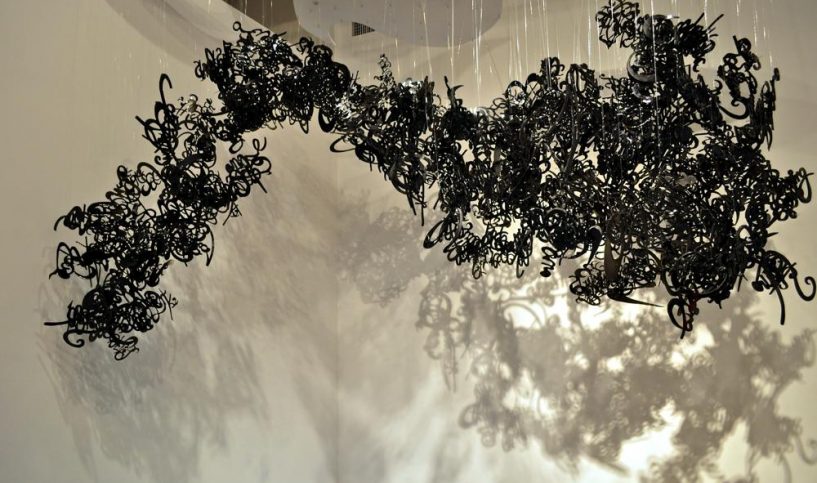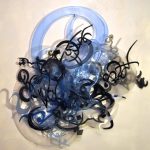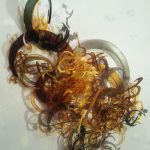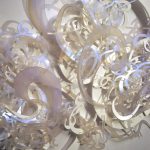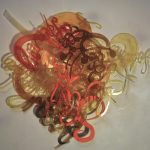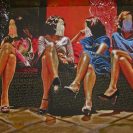“Words – written or spoken, understood or misunderstood, poetic or prosaic, curvilinear or rectilinear, are what motivate me to create my visual narrative”
There is something deeply intriguing about Simeen Farhat’s beautiful installations and speech bubbles. Farhat has a real knack for twisting simple words into interesting shapes and splashes of colors, which is her signature art style.
Farhat is a Texas-based artist, whose works are born of an intimate relationship with literature and philosophy.
“As a visual artist, my fascination is with the visual play or the juxtaposition of those text or words that I do pick selectively and carefully,” she says.
“The text in my sculptures and installations are revolutionary poems, appropriated mostly from famous Farsi and Urdu poets, such as Rumi, Saadi, Ghalib and Faiz Ahmed Faiz, who all wrote powerfully about freedom of thought and speech,” she adds.
Her installation artworks in resin cast are incredibly expressive and brilliantly underscored with abstract minimalism.
The visual effects of her installations and speech bubbles are playful and invite the viewer to engage with the narrative that spans cultural history, gender equality, identity and freedom.
“Through the interactive nature of my installations, sculptures, and textual drawings, I pose questions for each culture to examine from their own perspective: Considering that there is a figure but no embodied form showing, can this be called contemporary figurative Islamic Art? Do these life-size veiled figures threaten or confuse non-Muslim Westerners and why? Recognizing that this work represents women’s freedom to think, can this work be called a universally Feminist art?” she says in her artist statement.
This is Farhat’s first solo exhibition in Kuwait. Her work has been featured in various group shows including those at JAMM Kuwait, Pakistan, Bahrain, London, the UAE, India, Finland, Austria, Germany, Switzerland and the United States.
Farhat was born in Karachi, Pakistan, and received her MFA, Summa cum Laude from Texas Christian University Fort Worth, Texas. She lives in Dallas.
In this exclusive interview with bazaar, Simeen Farhat reflects on her artistic voyage and talks about her meticulously constructed installations and her upcoming exhibition in Kuwait. Words are central in her practice. “My upcoming show in Kuwait is certainly based on my fascination to play with words.”
You were born in Pakistan, how did that shape your artist identity?
Being a woman born in a patriarchal society, I would say, influenced in shaping my identity as an artist. Living in two separate cultures and countries for such a long time, as well as a lot of travelling in many parts of the world, also shaped my identity. I always try to carry what I think is good from each culture. It is not so important for me to brand myself with any particular identity; although, I can be branded as Pakistani-born or Pakistani-born-American artist. I actually find myself a multicultural artist with a multipoint perspective: I have numerous vanishing points.
You have developed your own idiom informed by your love for literature and poetry. Why do you use words as base for your installations and sculptures?
Literature, poetry, philosophy, music and art, all use language. We understand a great deal about ourselves, and things around us through language; and how we express ourselves or have knowledge, acquired by us though reading, seeing, thinking and feeling words. Earlier, I was more interested in words as they appeared to us visually, and that writing came first as gestures. But I became more and more interested about the philosophy behind those words; how words, in whatever order they are put into, their syntax, grammar, punctuations, and their sound and their meanings, change the whole context of something. Even simple words and phrases, and not just poetic and literary fascinate and inspire me to create my visual narrative.
But as a visual artist, my fascination is with the visual play or the juxtaposition of those text or words that I do pick selectively and carefully. I want them to lose their identity as literal objects or narratives into simple and complex lines, shapes, forms, colors, etc. The end result is visual philosophy.
My upcoming show in Kuwait is certainly based on my fascination of playing with words. I have used all kinds of words here for this show; whether they are borrowed from a poet, such as Ghalib or Ferdowsy, or my own attempts, or some email correspondence – in English or in Urdu. I have experimented with many possibilities, and interestingly, many titles for some of those pieces have the word “possibilities” in them.
What comes first: concepts, or words?
Sometimes concepts come first and then words follow. Other times, words come first and they evolve into some ideas. But I guess even simple words, for me, come as concepts.
Burqa-clad women are central to a number of your works. How does your work relate to your own issues of identity and gender?
Those works were some of the earlier works. Their concept was more about how mind and body are related; or work together or separately: One can capture or imprison a person’s body, but they cannot captivate their mind or their thought process. On the contrary, sometimes, a person’s thought and imagination is controlled and imprisoned through propaganda and rhetoric.
Many of your works are in fact experienced like stories with a subtle message, especially when one looks at your works during 2008 MAC exhibition. Can you elaborate on your installation titled ‘We Won’t Kill You’? How did these themes come about?
That theme was as a reaction to seeing more and more women in Pakistan covering themselves with hijab and burqa in the last two decades; a practice that did not used to be part of the Pakistani culture, and I did not experience it while growing up there. But I noticed those changes while not living in Pakistan permanently; but rather frequently visiting a few times a year. I saw the culture I was born in both as an insider and as an outsider. The installation was also about that those women still possessed a soul and mind that would continue to exist and be able to think. And lastly, unlike the stereotype in the Western society perhaps, they were not the suicide bombers.
There is another very interesting series based on the classic Alice’s Adventures in Wonderland. Can we talk a little about it?
Certainly! Alice is universal. She can be any child, a young girl, and a woman. She finds herself in funny, bizarre and confusing situations. Lately, I have been trying to incorporate stories or some characters form many cultures, literature, and philosophy of language, and using language as a metaphor in my work. “Alice’s Adventures in Wonderland” is one such metaphor of language, and of sense that ostensibly does not make sense. At times, I felt myself as Alice, as I found myself in situations where nothing would make sense. Unlike Alice, I didn’t change physically, but internally there were quite some roller coaster rides, turmoil and frustrations to deal with. Similarly, the appearing of and disappearing of several things – similar to “Cheshire cat” in the Wonderland, inspired me to make a few works; such as “Grin” and “Orange Smirk.” For Alice, it was a dream in the wonderland, but for me, they were all real.
How do you want people to feel and think when viewing your works?
I certainly do not want to control my viewers’ mind and their imagination. They can feel and think as they wish. I have had many interesting experiences where viewers have told me quite the opposite, or totally unexpected interpretations than what I had in my mind when I created those works. The more meanings and interpretations the better; I think.
Can you explain a little about your techniques?
I have been using resin cast as a medium for most of these works for the past few years. Resin is basically plastic and since I also like to control the colors and thickness of those words that become shapes and forms for my sculptures and installations, I find these materials and the technique more archival and with numerous possibilities.
What is next for you?
I like mystery! But I will give you a hint: body parts and anatomy.
Solo exhibition of works by artist Simeen Farhat’s opens at Dar Al Funoon Gallery on February 2 and runs through February 24. Stop by the gallery at Al Watiah, Behbehani Compound, House No 28. For more information on the artist, please visit www.simeen.net.
Images courtesy of the artist.

